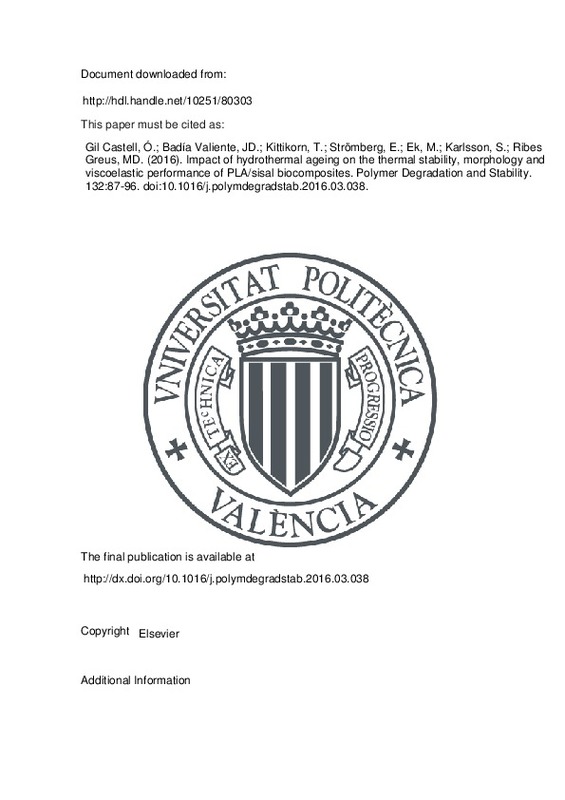JavaScript is disabled for your browser. Some features of this site may not work without it.
Buscar en RiuNet
Listar
Mi cuenta
Estadísticas
Ayuda RiuNet
Admin. UPV
Impact of hydrothermal ageing on the thermal stability, morphology and viscoelastic performance of PLA/sisal biocomposites
Mostrar el registro sencillo del ítem
Ficheros en el ítem
| dc.contributor.author | Gil Castell, Óscar
|
es_ES |
| dc.contributor.author | Badía Valiente, José David
|
es_ES |
| dc.contributor.author | Kittikorn, T.
|
es_ES |
| dc.contributor.author | Strömberg, E.
|
es_ES |
| dc.contributor.author | Ek, Martina
|
es_ES |
| dc.contributor.author | Karlsson, S.
|
es_ES |
| dc.contributor.author | Ribes Greus, María Desamparados
|
es_ES |
| dc.date.accessioned | 2017-05-02T10:07:36Z | |
| dc.date.available | 2017-05-02T10:07:36Z | |
| dc.date.issued | 2016-10 | |
| dc.identifier.issn | 0141-3910 | |
| dc.identifier.uri | http://hdl.handle.net/10251/80303 | |
| dc.description.abstract | The influence of the combined exposure to water and temperature on the behaviour of polylactide/sisal biocomposites coupled with maleic acid anhydride was assessed through accelerated hydrothermal ageing. The biocomposites were immersed in water at temperatures from 65 to 85 °C, between the glass transition and cold crystallisation of the PLA matrix. The results showed that the most influent factor for water absorption was the percentage of fibres, followed by the presence of coupling agent, whereas the effect of the temperature was not significant. Deep assessment was devoted to biocomposites subjected to hydrothermal ageing at 85 °C, since it represents the extreme degrading condition. The morphology and crystallinity of the biocomposites were evaluated by means of X-Ray diffraction (XRD) and field emission scanning electron microscopy (FE-SEM). The viscoelastic and thermal performance were assessed by means of dynamic mechanic thermal analysis (DMTA) and thermogravimetry (TGA). The presence of sisal generally diminished the thermal stability of the biocomposites, which was mitigated by the addition of the coupling agent. After composite preparation, the effectiveness of the sisal fibre was improved by the crystallisation of PLA around sisal, which increased the storage modulus and reduced the dampening factor. The presence of the coupling agent strengthened this effect. After hydrothermal ageing, crystallisation was promoted in all biocomposites therefore showing more fragile behaviour evidencing pores and cracks. However, the addition of coupling agent in the formulation of biocomposites contributed in all cases to minimise the effects of hydrothermal ageing. | es_ES |
| dc.description.sponsorship | The authors would like to acknowledge the Spanish Ministry of Economy and Competitiveness, through the Research Project ENE2014-53734-C2-1-R and UPOV13-3E-1947. The Spanish Ministry of Education, Culture and Sports is also thanked for the pre-doctoral FPU grant of O. Gil-Castell (FPU13/01916). Generalitat Valenciana is thanked for the APOSTD14/041 program for J.D. Badia. The Chilean Government is thanked for the 13CEI2-21839 project. The financial support given by the Prince of Songkla University and KTH Royal Institute of Technology is gratefully acknowledged. | en_EN |
| dc.language | Inglés | es_ES |
| dc.publisher | Elsevier | es_ES |
| dc.relation.ispartof | Polymer Degradation and Stability | es_ES |
| dc.rights | Reserva de todos los derechos | es_ES |
| dc.subject | Biocomposites | es_ES |
| dc.subject | Polylactide (PLA) | es_ES |
| dc.subject | Natural fibres | es_ES |
| dc.subject | Sisal | es_ES |
| dc.subject | Hydrothermal ageing | es_ES |
| dc.subject | Degradation | es_ES |
| dc.subject | Performance | es_ES |
| dc.subject | Mechanical fibre effectivenes | es_ES |
| dc.subject.classification | MAQUINAS Y MOTORES TERMICOS | es_ES |
| dc.subject.classification | CIENCIA DE LOS MATERIALES E INGENIERIA METALURGICA | es_ES |
| dc.title | Impact of hydrothermal ageing on the thermal stability, morphology and viscoelastic performance of PLA/sisal biocomposites | es_ES |
| dc.type | Artículo | es_ES |
| dc.identifier.doi | 10.1016/j.polymdegradstab.2016.03.038 | |
| dc.relation.projectID | info:eu-repo/grantAgreement/MINECO//ENE2014-53734-C2-1-R/ES/DISEÑO Y VALIDACION DE MEMBRANAS CON CONTROL MORFOLOGICO PARA SU USO EN PILAS DE COMBUSTIBLE DE BAJA TEMPERATURA SOSTENIBLES EN VEHICULOS EFICIENTES NO TRIPULADOS/ | es_ES |
| dc.relation.projectID | info:eu-repo/grantAgreement/MINECO//UPOV13-3E-1947/ES/Cromatrografía por Exclusión de Tamaños/ | es_ES |
| dc.relation.projectID | info:eu-repo/grantAgreement/MECD//FPU13%2F01916/ES/FPU13%2F01916/ | es_ES |
| dc.relation.projectID | info:eu-repo/grantAgreement/GVA//APOSTD14%2F041/ | es_ES |
| dc.relation.projectID | info:eu-repo/grantAgreement/CORFO//13CEI2-21839/CL/CENTRO DE EXCELENCIA EN NANOFIBRAS LEITAT CHILE (CEN LEITAT-CHILE/ | es_ES |
| dc.rights.accessRights | Abierto | es_ES |
| dc.contributor.affiliation | Universitat Politècnica de València. Instituto de Tecnología de Materiales - Institut de Tecnologia de Materials | es_ES |
| dc.contributor.affiliation | Universitat Politècnica de València. Escuela Técnica Superior de Ingeniería del Diseño - Escola Tècnica Superior d'Enginyeria del Disseny | es_ES |
| dc.description.bibliographicCitation | Gil Castell, Ó.; Badía Valiente, JD.; Kittikorn, T.; Strömberg, E.; Ek, M.; Karlsson, S.; Ribes Greus, MD. (2016). Impact of hydrothermal ageing on the thermal stability, morphology and viscoelastic performance of PLA/sisal biocomposites. Polymer Degradation and Stability. 132:87-96. https://doi.org/10.1016/j.polymdegradstab.2016.03.038 | es_ES |
| dc.description.accrualMethod | S | es_ES |
| dc.relation.publisherversion | http://dx.doi.org/10.1016/j.polymdegradstab.2016.03.038 | es_ES |
| dc.description.upvformatpinicio | 87 | es_ES |
| dc.description.upvformatpfin | 96 | es_ES |
| dc.type.version | info:eu-repo/semantics/publishedVersion | es_ES |
| dc.description.volume | 132 | es_ES |
| dc.relation.senia | 317137 | es_ES |
| dc.contributor.funder | Ministerio de Educación, Cultura y Deporte | es_ES |
| dc.contributor.funder | Corporación de Fomento de la Producción, Chile | es_ES |
| dc.contributor.funder | Generalitat Valenciana | es_ES |
| dc.contributor.funder | Prince of Songkla University | es_ES |
| dc.contributor.funder | Royal Institute of Technology, Suecia | es_ES |







![[Cerrado]](/themes/UPV/images/candado.png)

